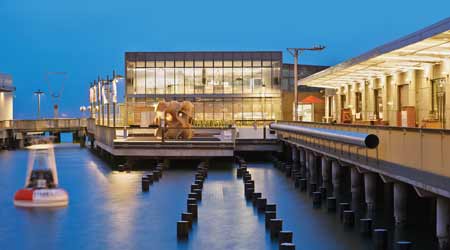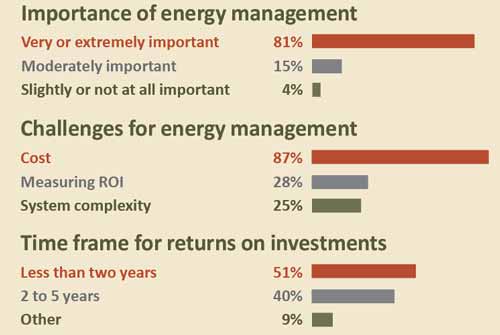 The Exploratorium in San Francisco, built in 1913, achieved zero net energy consumption through deep energy retrofits combined with onsite renewable energy produced by a rooftop photovoltaic array that generates 1.4 megawatts of electricity.Bruce Damonte
The Exploratorium in San Francisco, built in 1913, achieved zero net energy consumption through deep energy retrofits combined with onsite renewable energy produced by a rooftop photovoltaic array that generates 1.4 megawatts of electricity.Bruce Damonte Deep Energy Retrofits: First Step Toward Zero Energy Existing Buildings
From new financing to a building envelope improvement, several factors could trigger a deep energy retrofit, making an existing building a candidate for net zero energy.
In practical terms, for an existing building to achieve ZEB status, the critical first step is conducting a deep energy retrofit, which results in significant energy efficiency improvements. Standalone, the retrofit provides cost savings benefit regardless of whether the building attains net-zero status. Once deep energy retrofits are instituted, the building or building campus can undergo an energy assessment to size a new renewable energy system.
Deep energy retrofits result from a whole-building analysis and construction process which fundamentally enhance the building value and achieves much larger energy cost savings than do conventional, simple retrofits. Deep energy retrofit planning first evaluates all major capital improvements necessary over the next several years to serve as the baseline cost and then strategically evaluates opportunities for capturing other benefits such as managing utility costs, attracting and retaining desired employees and tenants, improved reputation and leadership, and complying with present and future sustainability reporting requirements. By simply recognizing how systems are interrelated, says the Rocky Mountain Institute, design teams can cause small improvements to cascade into substantially larger benefits.
During a building’s life-cycle, situations arise that provide opportunity to conduct a deep energy retrofit. According to the Rocky Mountain Institute, some of the triggers that could precipitate investigation of deep energy retrofits could include:
• Building purchase or refinancing, where attractive financing can be included in the transaction cost.
• A scheduled redevelopment project which could include deep efficiency measures at relatively low cost.
• Building envelope improvements (roof, window, siding), which combined with major end of life components such as HVAC and lighting, offers many potential synergies such reduced heating/cooling load reducing HVAC equipment size
• Life safety upgrades to meet code may cause substantial disruption and cost that is enough to justify major efficiency improvements.
• Extremely inefficient buildings can have such high energy use that a deep energy retrofit would be a cost effective alternative to doing nothing.
• Tenant turnover may provide an opportunity to improve energy and space efficiency, increase the value of the space, and potentially leverage new tenant investment in the build out.
• Total energy planning and efficiency improvements for a portfolio of properties may provide deep retrofit project economies of scale.
The value that can be gained from a deep energy retrofit can include a reduction in O&M costs, increased occupancy rates, higher rents, increased productivity, and increased occupancy rates. It can also change the dynamics of intangible externalities such as reduction in absenteeism and employee attrition, improved marketability of both employee and clients and increased employee productivity. Deep energy retrofits can also reduce risk from energy market instability and price volatility, says the Rocky Mountain Institute.
Capital improvement analysis typically utilizes simple payback based on energy cost savings alone, using traditional discounted cash flow analysis over the building ownership time period; by contrast, deep energy retrofit financial analysis should consider other non-energy-cost values that benefit building owners and occupants. The Rocky Mountain Institute identifies the following variables.
• Operation expenditure savings ($/square foot/year), primarily through reduction of energy use.
• Value beyond energy costs savings (can be quantified in dollars per square foot per year). This is the least common source of value to be quantified, but often is a key driver during decision-making. This can include improvement to the building envelope, passive design improvements (e.g., natural light and ventilation, landscaping) that can improve occupancy rates, and employee productivity.
• Gross capital cost (dollars per square foot) disaggregates the cost for efficiency from the rest of the project, which often includes major renovations for non-efficiency purposes. Deep energy retrofit costs can be substantial and on the high end can be very large; for example a standard 500,000-gross-square foot, 12-story office building could cost $25 per square foot at minimum and potentially over $150 per square foot.
• Avoided capital costs (dollars per square foot) are capital improvement projects that are obviated as a result of pursuing deep energy retrofits. For example, a window replacement project could result in avoidance of a chiller replacement.
Energy efficiency programs, as with any capital improvement program, have inherent risks, from underperforming efficiency measures to uncooperative building occupant behavior. During the planning phase of the project, it is wise to understand common risks and best practices and their management and mitigation. Examples of risk and mitigation measures include:
• Energy use exceeding predictions, which can be mitigated through predictive energy-modeling accounting for weather variation.
• Unfavorable occupant behavior, which can be mitigated through occupant engagement during the design phase.
• New, more cost-effective technology emerging during construction, which can be mitigated through research during the design phase and flexibility to upgrade during operation.
• Facility management staff operating a building ineffectively, which can be mitigated through development of standard operating procedures, training, and inclusion of staff during the design phase.
Perhaps the most critical step of the planning process is selling the project to management. This final step is as much storytelling as it is sales pitch. Priorities are organization-specific; therefore identify what is important to management and build the case around those priorities. Start with the “why.” For instance, tenants may be choosing a competitor’s building, despite higher rent, based on enhanced environmental factors, such as, common space and natural light. Perhaps the building operates at a slight profit margin that could be dramatically increased with energy efficiency improvements.
____________________________________________________________________________
CHART: Energy Efficiency Challenges: Time and Money
For facility managers who are not yet at the point where they can perform a deep energy retrofit, even a more limited energy upgrade can produce significant savings. And many organizations consider energy efficiency a high priority, according to a recent survey by Building Operating Management and Penton. But the survey shows that upgrades require two organizational resources that are often in short supply: money and patience. (Answers may total to more than 100 percent because multiple responses sometimes allowed.)

Related Topics:
















